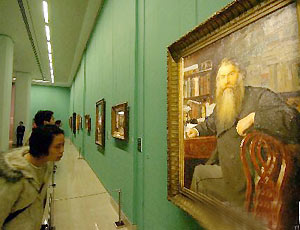
Thousands of visitors are flooding the National Art Museum of
China in downtown Beijing to experience the enriching world of
Russian culture, history and society, as revealed through the eyes
of the country's master painters.
Heavyweight masters
The first of nine major art exhibitions in the Year of Russia in
China which kicked off early last week, the "Russian Art in 300
Years" exhibition showcases 110 selected oil paintings by Russian
master painters from the 18th to 20th centuries. These artists
include Kramskoy (1837-87), Repin (1844-1930), Surikov (1848-1916),
Levitan (1861-1900), and Shishkin (1832-98), who are well-known
among Chinese artists and educators today.
The grand exhibition is divided into four parts: Russian art
from the 18th to 19th centuries, from the 1870s, from the late 19th
to early 20th centuries, and during the Soviet Union era.
Among the most eye-catching artworks on show are the portraits
from masters such as Kramskoy and Repin, members of the so-called
Society for Travelling Art Exhibitions or "Itinerants" who embodied
and gave creative force to Russian art of the period.
The largest art show from Russia in China, the exhibition is
co-organized by the National Art Museum of China and the
Moscow-based State Tretyakov Art Gallery, Russia's national museum
of fine arts.
The Tretyakov Gallery, founded in 1856 as a private collection,
is the biggest museum of Russian fine arts. The rich collections of
icons, paintings, sculptures, monumental canvases and jewellery
pieces are gathered in the museum.
"Some 150 years ago, young Russian merchant Pavel M Tretyakov
(1832-98) purchased the first artworks for his private collection.
Before he died, he donated the artworks he gathered from over 40
years to the public. He is one of the most-respected men in Russian
history," said Ekaterina L Selezneva, deputy director of State
Tretyakov Art Gallery, at a recent press conference in Beijing.
"We hope that our exhibition in Beijing will attract attention
from Chinese art enthusiasts, especially the younger
generations."
Along with the big show of Russian art in the past 300 years, an
exhibition featuring contemporary Russian art is also being held at
the same museum in Beijing, with some 100 selected pieces including
oil paintings, sculpture, and installations.
"The Russian art exhibitions offer Chinese viewers a rare chance
to know about Russian people and their history and culture, and
dramatic changes in Russian society as conveyed by the works of
Russian artists," said Fan Di'an, director of the National Art
Museum of China.
To create a better impression of Russian art on Chinese viewers,
the National Art Museum of China has prepared tour guides,
electronic guide equipment, and a series of academic lectures by
Chinese scholars for the visitors, according to Fan.
His museum has even made special designs and decorations for its
display halls, on the third floor of the main building, in a style
similar to that of the Moscow-based State Tretyakov Art
Gallery.
These two exhibitions will wrap up on May 15, the organizers
say.
Influence on China
Russian art and literature possesses a peculiar charm for
Chinese people. Dramas, movies, songs, paintings and novels from
Russia were extremely popular among Chinese since the founding of
New China in 1949.
Russian songs are frequently heard in today's karaoke parlours
across China.
About three years ago, some Chinese TV producers even did TV
versions of some Russian movies once popular among older Chinese
audiences in the 1970s, with actors and actresses from Russia and
other former Soviet Union nations.
But Russian oil art, in particular, has exerted a strong
influence upon oil painters on the Chinese mainland, particularly
in the 1950-70s, said Xi Jingzhi, a Beijing-based senior researcher
in Russian art.
For instance, famous Russian artist K M Maksimov (1913-93) came
and taught in China from 1955-1957 at the Central Academy of Fine
Arts in Beijing.
Many of his students, including Jin Shangyi, chairman of Chinese
Artists Association, and Zhan Jianjun, chairman of Chinese Oil
Painters Society, have become the mainstay of Chinese oil painting
circles.
The Russian influence is still strong even today, although the
Chinese art scene is much more diversified than it was decades ago,
she said.
However, she pointed out, during the "cultural revolution"
(1966-76), many Chinese artists had only copied rigidly from their
Russian counterparts the painting techniques and "revolutionary"
subjects. But she said they largely failed to learn about the
Russian artists' emphasis on human conditions at lower social
classes and their deep compassion for the underprivileged.
(China Daily March 28, 2006)
|

